| Steyr
Puch incorporated a
drive shaft "decoupler" into its design of the
syncro, which allowed the driver to engage and disengage power
to the
front differential. With a few exceptions, it never made it into
production.
The
basic design and parts are depicted in ETKA, although only some of them
are available from VW. The critical parts are not
available.
The reason that the decoupler never made it into production appears to
be that it was designed primarily for the few very early production
syncros
that did not have a viscous coupling. On those syncros, the drive
shaft needed to be disconnected when four wheel drive was not being
used
or was not needed in order to reduce stress on the transmission and
improve
drivability on paved roads.
The
incorporation of a viscous coupling rendered the decoupler
redundant. The
VC
acts as an automatic decoupler or disengager. In theory, it
transmits
power to the
front wheels only when there is a differential in speed between the
front
and rear wheels. If there is no slippage or differential in
speed,
the main drive shaft is in effect disconnected from the front wheels
since
the VC is spinning freely and not transmitting any power. Thus
there
is, in theory at least, no need for a drive shaft decoupler.
In
reality, however, the VC
does
not function flawlessly under all driving conditions. Even on
straight
freeway, the VC transmits some torque to the front differential.
On twisty roads, the VC gets a good workout and in turn transmits
additional
stresses to the entire drive train. And if the VC is on the
aggressive
side, or is aging, it can engage on hot days after high speed traveling
to an extent that does cause wind up in the drive train, and hence
undue strain on the components. For this reason, many believe
that a
decoupler
saves wear and tear on the drive train (particularly during
high-speed freeway driving in hot temperatures) and thus prolongs
its life.
Others claim that the decoupler does not save on wear
and tear, and note that the benefits of AWD are lost with it.
|
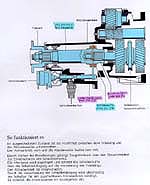 |
If
the VC is removed and a straight shaft is put in its place, a decoupler
becomes essential. This converts the syncro back to the pre-VC
early
production stages. Why would anyone do that? At Syncro de
Mayo this
year, a couple of vans had the straight shaft-decoupler set up.
It was
obvious to the casual observer that
the straight shaft syncros out-performed the VC equipped syncros in the
toughest off-road conditions.
The syncros with VCs were not as sure-footed and not as smooth over the
really rough and steep terrain. While it appears, therefore, that
a
straight-shaft - decoupler combo is a sure thing when it comes to
enhancing the syncro's off-road 4WD performance,
the straight shaft precludes use
of 4WD on paved roads, except on
snowy and slick roads that allow some wheel slippage.
Decouplers
are available from enterprising inventors in South Africa, Germany and
the US. There are two designs. The South African and German
designs
are depicted in the photo on the left below and track the VW design
depicted in the drawing, above. The US design uses a different
approach for mating two shafts together, but otherwise
functions the same. The South African kit required assembly
and also machining of the nosecone casing to accept the actuator rod,
the switch and mounting plate, which is a job that requires machine
tools. The German and US kits come pre-assembled.
Installation
takes about 4 hours and is not a complex job, nor does it require
special tools (see photos linked below).
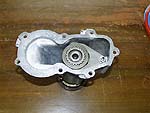
South African & German Design
|
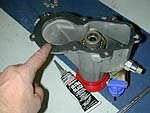
US design
|
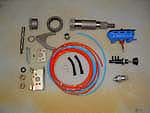
South African Decoupler Kit
|
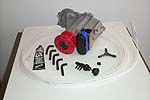
US
Decoupler Kit
|
 Decoupler
Installation Photo Decoupler
Installation Photo |